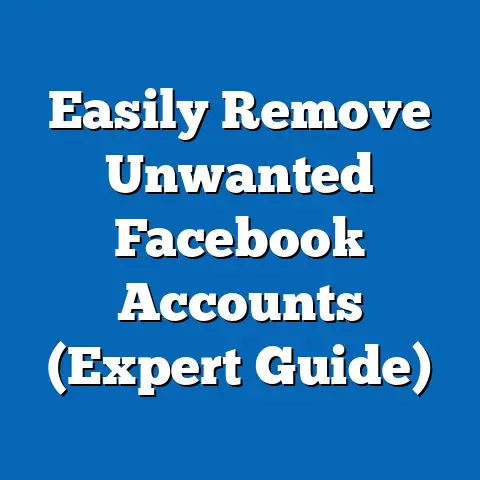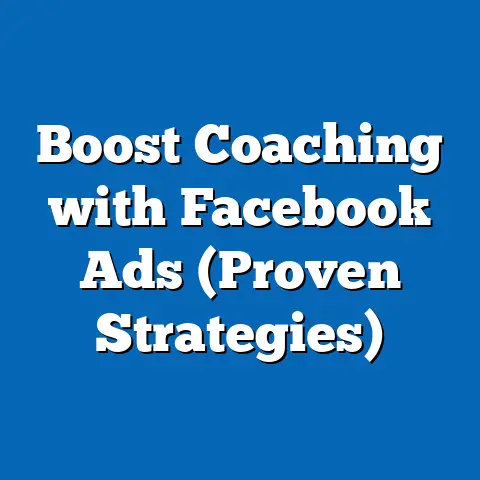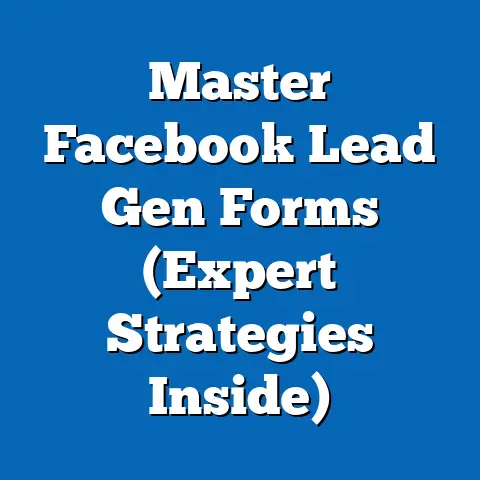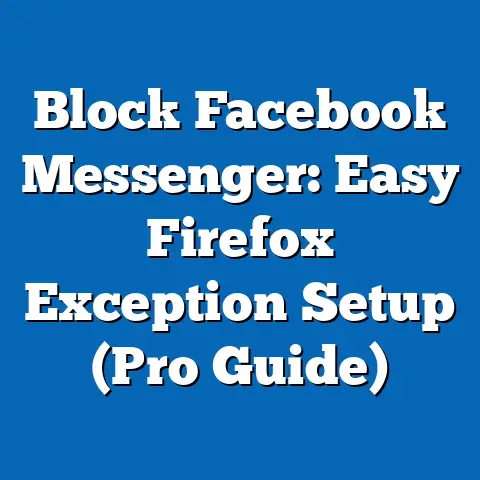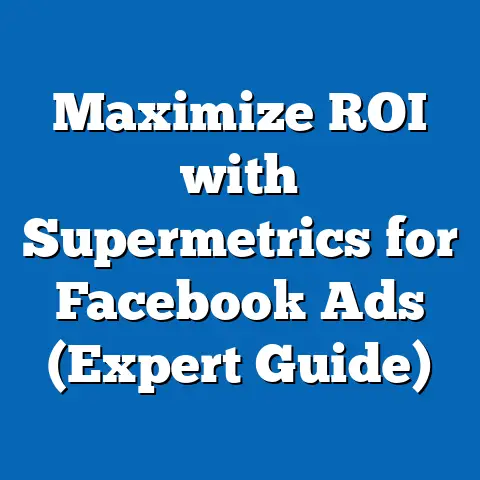Why Facebook Ads Are Disappearing (Essential Solutions)
In a world where social media reigns supreme, it’s ironic that Facebook—once the undisputed king of digital advertising—seems to be losing its grip on the very ads that fueled its meteoric rise. With over 2.9 billion monthly active users as of 2023 (Statista, 2023), Facebook remains a colossal platform, yet advertisers are increasingly pulling back, with some reporting a 20% drop in ad spend on the platform between 2021 and 2023 (eMarketer, 2023). What’s driving this unexpected shift, and how can businesses adapt to a landscape where even the giants stumble?
Section 1: The Numbers Behind the Decline
The decline in Facebook ads isn’t mere speculation; it’s a trend backed by hard data. According to eMarketer, global ad revenue growth for Meta (Facebook’s parent company) slowed to just 6.1% in 2022, down from a staggering 36.7% in 2021. This marks one of the slowest growth rates in the platform’s history, signaling a significant shift in advertiser confidence.
Moreover, a 2023 survey by Insider Intelligence revealed that 34% of small-to-medium businesses (SMBs) reduced their ad budgets on Facebook in the past year, citing lower return on investment (ROI) compared to competitors like TikTok and Google. Geographically, the decline is most pronounced in North America, where ad spend dropped by 12% year-over-year in 2022, while regions like Asia-Pacific saw only modest growth of 4% (eMarketer, 2023). These figures paint a clear picture: advertisers are rethinking their reliance on Facebook.
Demographically, the platform’s user base is also shifting. While Facebook still boasts a broad audience, its growth among younger users (ages 18-24) has stagnated, with only a 2% increase in this group between 2021 and 2023 (Pew Research Center, 2023). In contrast, platforms like TikTok have seen a 25% surge in the same demographic over the same period. As advertisers chase younger, trend-driven audiences, Facebook’s aging user base—now skewing toward 35-54-year-olds—may be contributing to the ad exodus.
Section 2: Historical Trends vs. Current Realities
To understand the current decline, it’s worth looking at Facebook’s historical dominance in digital advertising. In 2017, Facebook accounted for 19.9% of global digital ad spend, second only to Google, with year-over-year revenue growth often exceeding 40% (eMarketer, 2017). The platform’s precise targeting tools, fueled by vast user data, made it a goldmine for advertisers seeking high engagement and conversion rates.
Fast forward to 2023, and the landscape has changed dramatically. While Meta still holds a significant 21.5% of global digital ad spend, its growth has plateaued, and competitors like TikTok (projected to capture 3.5% of the market by 2024) are gaining ground rapidly (Insider Intelligence, 2023). Historically, Facebook’s strength lay in its ability to adapt—whether through acquisitions like Instagram or innovations like Stories—but recent challenges suggest it’s struggling to keep pace with user and advertiser expectations.
One stark contrast is the cost of advertising. In 2018, the average cost-per-click (CPC) on Facebook was $0.27, making it an affordable option for businesses of all sizes (WordStream, 2018). By 2023, that figure had risen to $0.97, a 259% increase, driven by increased competition and reduced ad inventory due to privacy restrictions (WordStream, 2023). This price hike, coupled with declining ROI, is pushing advertisers to explore alternatives.
Section 3: Key Reasons for the Disappearance of Facebook Ads
3.1 Apple’s Privacy Changes and the Data Dilemma
One of the most significant blows to Facebook’s ad ecosystem came in 2021 with Apple’s introduction of iOS 14.5 and its App Tracking Transparency (ATT) framework. This update required apps to ask users for permission to track their activity across other apps and websites—a change that directly impacted Facebook’s ability to deliver personalized ads. According to Meta’s own estimates, this policy cost the company $10 billion in ad revenue in 2022 alone (Meta Q4 Earnings Report, 2022).
Data from Flurry Analytics (2021) shows that only 25% of iOS users globally opted in to tracking after the update, severely limiting the data pool available for targeted advertising. Without granular user data, ad effectiveness plummets, and advertisers are left questioning the platform’s value. This privacy shift has disproportionately affected SMBs, which rely on precise targeting to compete with larger brands.
3.2 Platform Fatigue and Shifting User Behavior
Another factor is platform fatigue among users. A 2022 study by the Digital Marketing Institute found that 41% of surveyed users aged 18-34 reported spending less time on Facebook compared to two years prior, often citing repetitive content and an oversaturation of ads as reasons. As users scroll less, ad impressions decline—directly impacting revenue potential.
Additionally, younger demographics are flocking to visually driven, short-form content platforms like TikTok and Instagram Reels. TikTok, for instance, reported a 60% increase in daily active users in the U.S. between 2021 and 2023, while Facebook saw only a 3% uptick (Sensor Tower, 2023). Advertisers are following suit, reallocating budgets to platforms where engagement is higher.
3.3 Rising Costs and Diminishing Returns
The escalating cost of Facebook ads, as mentioned earlier, is a major deterrent. A 2023 report by Socialbakers found that the average cost-per-mille (CPM) on Facebook rose by 47% between 2020 and 2022, while click-through rates (CTR) dropped from 1.11% to 0.90% in the same period. This means advertisers are paying more for less engagement—a losing proposition for many.
Larger brands with bigger budgets can absorb these costs, but SMBs, which make up a significant portion of Facebook’s advertiser base, are struggling. A survey by Hootsuite (2023) revealed that 52% of SMBs felt Facebook ads were no longer cost-effective, compared to just 29% in 2019. This dissatisfaction is driving a slow but steady migration to other platforms.
3.4 Regulatory Pressures and Brand Safety Concerns
Regulatory scrutiny is another hurdle. In the European Union, the General Data Protection Regulation (GDPR) and upcoming Digital Markets Act have imposed strict rules on data usage and advertising practices. Meta was fined €390 million in 2023 for GDPR violations related to personalized ads (European Data Protection Board, 2023), further eroding trust among advertisers wary of legal risks.
Brand safety is also a growing concern. High-profile controversies, including misinformation scandals and content moderation failures, have made some advertisers hesitant to associate with the platform. A 2022 survey by the World Federation of Advertisers found that 31% of global brands reduced ad spend on Facebook due to concerns over brand reputation, up from 18% in 2020.
Section 4: Demographic Differences and Patterns
The decline in Facebook ads isn’t uniform across demographics or regions, and understanding these patterns is crucial for marketers. In the U.S., where 70% of adults use Facebook (Pew Research Center, 2023), ad spend has dropped most sharply among campaigns targeting Gen Z (ages 18-24), with a 28% reduction in budget allocation since 2021 (eMarketer, 2023). This aligns with the demographic’s preference for platforms like Snapchat and TikTok, where engagement rates are often double those of Facebook.
Conversely, ad spend targeting older users (ages 45-64) has remained relatively stable, with only a 5% decline over the same period. This group, which represents 26% of Facebook’s U.S. user base, continues to engage with the platform for news and community content, making it a safer bet for certain industries like healthcare and finance (Nielsen, 2023).
Regionally, emerging markets in Africa and Latin America still show growth in ad spend, with increases of 8% and 6%, respectively, in 2022 (Insider Intelligence, 2023). These regions have younger, growing user bases and less competition from alternative platforms, offering a temporary buffer for Meta. However, as global privacy regulations tighten, even these markets may face challenges.
Section 5: Data Visualization Description
To illustrate the decline in Facebook ads, imagine a line graph titled “Facebook Ad Spend Growth Rate (2017-2023).” The x-axis represents years, while the y-axis shows percentage growth in global ad revenue. From 2017 to 2021, the line climbs sharply, peaking at 36.7% growth in 2021. Post-2021, the line dips dramatically, falling to 6.1% in 2022 and hovering near 5% in 2023 (based on eMarketer data).
A second visualization could be a bar chart titled “Ad Spend Allocation by Platform (2021 vs. 2023),” comparing Facebook, TikTok, and Google. In 2021, Facebook’s bar towers at 24% of total digital ad spend, while TikTok sits at 1.5%. By 2023, Facebook’s bar shrinks to 21.5%, while TikTok’s rises to 3%. This visual would highlight the redistribution of ad budgets across platforms, reinforcing the competitive pressures Facebook faces.
Section 6: Essential Solutions for Advertisers
While the challenges are real, advertisers can adapt to the changing landscape with strategic solutions. Below are actionable steps to mitigate the impact of disappearing Facebook ads and maintain marketing effectiveness.
6.1 Diversify Across Platforms
With Facebook’s ROI declining, diversification is key. Platforms like TikTok offer lower CPCs (averaging $0.50 in 2023) and higher engagement rates, particularly for younger audiences (WordStream, 2023). Google Ads, with its intent-driven search capabilities, also provides a strong alternative, boasting an average conversion rate of 3.75% compared to Facebook’s 1.85% (Google Ads Benchmark Report, 2023).
Businesses should allocate a portion of their budget—say, 20-30%—to test emerging platforms while maintaining a presence on Facebook for older demographics. This balanced approach minimizes risk and maximizes reach.
6.2 Focus on Organic Content and Community Building
As ad costs rise, organic content offers a cost-effective way to engage audiences. A 2023 study by Sprout Social found that 66% of Facebook users follow brands for updates and promotions, suggesting that consistent, value-driven posts can drive engagement without heavy ad spend. Invest in video content and interactive formats like polls, which tend to garner 40% more engagement than static posts (Socialbakers, 2023).
Building communities through Facebook Groups is another powerful tactic. Groups foster loyalty and provide a space for direct customer interaction, reducing reliance on paid ads for visibility.
6.3 Adapt to Privacy-First Advertising
With data tracking limitations in place, advertisers must pivot to privacy-compliant strategies. Contextual targeting—placing ads based on content rather than user behavior—is gaining traction. For instance, a travel company could target ads on travel-related Facebook Pages, bypassing the need for personal data.
Meta’s own tools, like the Conversions API, allow businesses to track conversions without relying on third-party cookies, though implementation requires technical expertise. Early adopters of such tools report a 15% improvement in ad performance compared to traditional tracking methods (Meta Business Insights, 2023).
6.4 Optimize for Cost Efficiency
To combat rising costs, advertisers should refine their targeting and creative strategies. A/B testing ad copy and visuals can improve CTR by up to 30%, according to a 2023 WordStream report. Focus on high-intent audiences, such as retargeting website visitors, which typically yields a 2-3x higher conversion rate than cold audiences (Facebook Ads Manager Data, 2023).
Additionally, consider scheduling ads during off-peak hours to reduce CPMs. Data from Socialbakers (2023) shows that ads run on weekends often cost 20% less than weekday slots, with comparable engagement in many industries.
6.5 Leverage First-Party Data
With third-party data becoming scarce, first-party data—collected directly from customers via surveys, website interactions, or CRM systems—is invaluable. Businesses that integrate first-party data into their Facebook campaigns report a 25% higher ROI compared to those relying solely on platform data (Forrester, 2023).
Encourage email sign-ups or loyalty program participation to build a robust data pool. This approach not only enhances targeting but also aligns with privacy regulations, future-proofing ad strategies.
Section 7: Broader Implications and Future Trends
The disappearance of Facebook ads signals a broader shift in the digital advertising ecosystem—one where privacy, user experience, and platform competition take center stage. As Meta grapples with these challenges, its ability to innovate will determine whether it can reclaim its dominance or cede further ground to rivals. The company’s heavy investment in the metaverse (with $13.7 billion spent in 2022 alone, per Meta Financials) suggests a long-term pivot, but short-term ad revenue struggles may persist.
For advertisers, the lesson is clear: adaptability is non-negotiable. The digital landscape is evolving faster than ever, with 54% of marketers planning to increase budgets on short-form video platforms like TikTok by 2025 (HubSpot, 2023). Those who cling to outdated strategies risk being left behind, while those who embrace diversification and privacy-first approaches are likely to thrive.
Beyond individual businesses, the trend raises questions about the sustainability of ad-driven social media models. If platforms like Facebook cannot balance user privacy with advertiser needs, we may see a shift toward subscription-based or hybrid revenue models in the coming decade. For now, the data suggests a challenging road ahead for Facebook ads—but with the right strategies, marketers can navigate this uncertainty and find success in a fragmented digital world.
Conclusion
Facebook ads may be disappearing from the budgets of many advertisers, but the story is far from over. With ad revenue growth slowing to 6.1% in 2022, costs rising by over 250% since 2018, and younger demographics drifting to competitors, the platform faces unprecedented headwinds. Yet, by diversifying platforms, leveraging organic content, and adapting to privacy changes, businesses can weather this storm.
The broader implication is a digital ad space in flux, where no single platform can claim unchallenged dominance. As we move forward, staying informed and agile will be the key to marketing success. Facebook may no longer be the automatic choice for advertisers, but with strategic adjustments, it can still play a valuable role in a multi-channel world.

